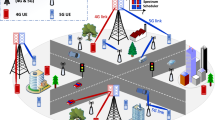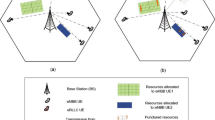Abstract
As radio access technology has been greatly developed nowadays, dynamic spectrum allocation (DSA), with which secondary users (SUs) are able to access the spectrum allocated to primary users becomes an important method for service providers to efficiently utilize limited wireless resources. Meanwhile, call admission control of SUs in an environment with multiple possible heterogenous wireless networks supporting DSA is also evolving. In this paper, we propose a pricing-based resource allocation scheme for multiple cooperative providers. According to this scheme, SUs are charged based on current system state by service provider to join one of several radio access networks (RANs). We integrate stochastic call admission control with dynamic pricing and formulate the problem of maximizing the expectation of system revenue in the long run as an infinite horizon average reward problem which can be solved by stochastic dynamic programming. Characteristics of the optimal pricing policy are analyzed based on series of computation results under various system conditions. Simulations carried out for a small network model show that a maximum profit can be achieved under our scheme and this maximum value varies with primary user arriving rates, primary user blocking punishments and channel capacities. Using our scheme, the system income could be improved by nearly 60 % in particular cases. Also, if each RAN’s probability of admitting a SU is carefully chosen, the system profit can be maximized and primary user blocking count minimized.









Similar content being viewed by others
References
FCCSPT: Report of the spectrum efficiency working group. Technical Report. November 2002.
Norton, M. (2007). Dynamic Spectrum Management.
Haykin, S. (2007). Cognitive radio: brain-empowered wireless communications. IEEE Journal on Selected Areas in Communications, 23(2), 201–220.
MacKie-Mason, J. K., & Varian, H. R. (1995). Pricing the internet. Public access to the internet (pp. 269–314).
Courcoubetis, C., Kelly, F. P., Siris, V. A., & Weber, R. (2000). A study of simple usage-based charging schemes for broadband networks. Telecommunication Systems, 15(3), 323–343.
Courcoubetis, C., & Weber, R. (2003). Pricing communication networks. Wiley Online Library, vol 2.
Hou, J., Yang, J., & Papavassiliou, S. (2002). Integration of pricing with call admission control to meet qos requirements in cellular networks. IEEE Transactions on Parallel & Distributed Systems, 13(9), 898–910.
Paschalidis, I. C., & Tsitsiklis, J. N. (2000). Congestion-dependent pricing of network services. IEEE/ACM Transactions on Networking, 8(2), 171–184.
Paschalidis, I. C., & Liu, Y. (2002). Pricing in multiservice loss networks: Static pricing, asymptotic optimality, and demand substitution effects. IEEE/ACM Transactions on Networking, 10(3), 425–438.
Chen, I. R., Yilmaz, O., & Yen, I. L. (2006). Admission control algorithms for revenue optimization with QoS guarantees in mobile wireless networks. Wireless Personal Communication, 38(3), 357–376.
Zachariadis, G., & Barria, J. A. (2008). Dynamic pricing and resource allocation using revenue management for multiservice networks. IEEE Transactions on Network & Service Management, 5(4), 215–226.
Elias, J., & Martignon, F. (May 2010). Joint spectrum access and pricing in cognitive radio networks with elastic traffic. IEEE international conference on communications, ICC 2010 (pp. 1–5).
Gizelis, C. A., & Vergados, D. D. (2011). A survey of pricing schemes in wireless networks. Communications Surveys & Tutorials, IEEE, 13(1), 126–145.
Mutlu, H., Alanyali, M., & Starobinski, D. (2009). Spot pricing of secondary spectrum usage in wireless cellular networks. IEEE/ACM Transactions on Networking, 17(6), 1794–1804.
Niyato, D., & Hossain, E. (2008). Competitive pricing for spectrum sharing in cognitive radio networks: Dynamic game, inefficiency of nash equilibrium, and collusion. IEEE Journal on Selected Areas in Communications, 26(1), 192–202.
Khan, M. A., Toker, A. C., Sivrikaya, F., & Albayrak, S. (2011). Cooperation-based resource allocation and call admission for wireless network operators. Telecommunication Systems, 51, 1–13.
Wang, X., Zhuo, C., Xu, Y., & Wang, R. (November 2007). A new stochastic admission control scheme for wireless networks.In Proceedings of IEEE GLOBECOM (pp. 807–811).
Fang, Y., & Zhang, Y. (2002). Call admission control schemes and performance analysis in wireless mobile networks. IEEE Transactions on Vehicular Technology, 51(2), 371–382.
Akl, R. G., Hegde, M. V., & Naraghi-Pour, M. (2005). Mobility-based CAC algorithm for arbitrary call-arrival rates in CDMA cellular systems. IEEE Transactions on Vehicular Technology, 54(2), 639–651.
Yilmaz, O., Furuskar, A., Pettersson, J., & Simonsson, A. (2005). Access selection in WCDMA and WLAN multi-access networks. Vehicular Technology Conference, 4, 2220–2224.
Gelabert, X., Pérez-Romero, J., Sallent, O., & Agustí, R. (2008). A Markovian approach to radio access technology selection in heterogeneous multiaccess/multiservice wireless networks. IEEE Transactions on Mobile Computing, 7, 1257–1270.
Lai, J., Dutkiewicz, E., Liu, R., Vesilo, R., & Fang, G. (2011). Network selection in cooperative cognitive radio networks. IEEE 11th international symposium on communications and information technologies (ISCIT) (pp. 378–383).
Lai, J., Dutkiewicz, E., Liu, R., & Vesilo, R. (2011). Joint admission control for cooperative cognitive radio networks. IEEE 6th international ICST conference on cognitive radio oriented wireless networks and communications (CROWNCOM) (pp. 276–280).
Bertsekas, D. (1995). Dynamic programming and optimal control. MA, Belmont: Athena Scientific Belmont.
Acknowledgments
This paper is supported by the National Grand Fundamental Research 973 Program of China under Grant No. 2011CB302-905, the National Science Foundation of China under Grant No. 61170058, National Science and Technology Major Project under Grant No. 2011ZX03005-004-04 and 2012ZX03005009, the Natural Science Foundation of Jiangsu Province in China under Grant No. BK2009150 and Research Fund for the Doctoral Program of Higher Education of China No. 20103402110041.
Author information
Authors and Affiliations
Corresponding author
Rights and permissions
About this article
Cite this article
Zhang, H., Huang, L., Xu, H. et al. Cooperative optimal pricing for stochastic access control in overlaid radio access networks. Telecommun Syst 60, 3–16 (2015). https://doi.org/10.1007/s11235-014-9917-0
Published:
Issue Date:
DOI: https://doi.org/10.1007/s11235-014-9917-0




